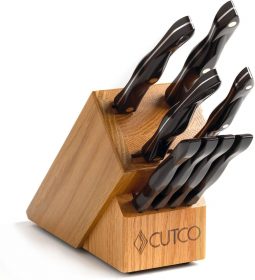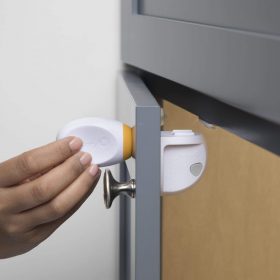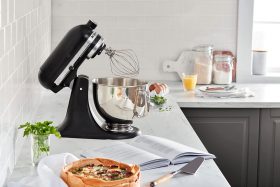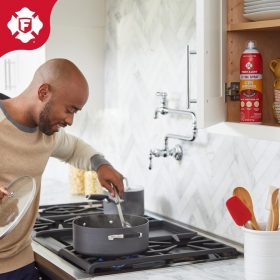In the home, the kitchen is a place filled with creativity and warmth. However, it also presents some potential safety hazards. To ensure kitchen safety, it is essential to understand and follow some basic safety principles. This guide will provide detailed kitchen safety tips, covering fire prevention, knife safety, and more, to help you maintain safety and peace of mind while cooking.
I. Fire Prevention
Fire is one of the most common and dangerous hazards in the kitchen. Here are some crucial measures to prevent kitchen fires:
1. Install Smoke Alarms:
- Function: Smoke alarms can alert you at the early stages of a fire, helping you take action promptly.
- Maintenance: Regularly check smoke alarms to ensure the batteries are fully charged.
2. Keep Cooking Area Clean:
- Reason: Grease and food residues can easily ignite, increasing the risk of fire.
- Method: Clean the stovetop and surrounding area promptly after each use, especially grease and food residues.
3. Monitor Cooking Process:
- Supervision: Do not leave cooking food unattended, especially when frying or sautéing.
- Timers: Use timers to remind yourself to check the cooking status, avoiding prolonged cooking that could lead to fires.
4. Use Appliances Properly:
- Check Appliances: Ensure kitchen appliances like microwaves and ovens are in good condition, with undamaged cords.
- Follow Instructions: Adhere to the usage instructions of appliances and avoid overloading them.

II. Knife Safety
Knives are essential kitchen tools, but they also pose certain safety risks. Here are some tips for using knives safely:
1. Choose the Right Knives:
- Type: Select appropriate knives for different ingredients, such as vegetable knives and meat knives.
- Quality: Use high-quality, sharp knives to reduce the risk of slips due to improper force.
2. Use Proper Cutting Techniques:
- Posture: Keep the blade facing away from yourself and others.
- Finger Position: Use a “claw” grip to keep fingers bent and avoid cutting them.
3.Maintain Knives Regularly:
- Sharpening: Regularly sharpen knives to keep the blades sharp, reducing the risk of slips.
- Cleaning: Clean and dry knives immediately after use to prevent rust and bacteria growth.
4. Store Knives Safely:
- Knife Block: Use a knife block or magnetic strip to store knives, avoiding exposed blades.
- Sheaths: Equip knives with sheaths to prevent accidental injuries during storage.

III. Appliance Safety
The safe use of kitchen appliances is also crucial for ensuring kitchen safety. Here are some safety precautions for using appliances:
1. Check Electrical Cords:
Regular Inspections: Regularly check the cords and plugs of appliances to ensure there are no damages or aging.
Keep Dry: Avoid exposing appliances to water while in use to prevent electrical accidents.
2. Operate Properly:
Read Manuals: Carefully read the user manuals of appliances and operate them correctly.
Load Limits: Avoid overloading appliances to prevent overheating or damage.
3. Regular Maintenance:
Cleaning: Regularly clean appliances, especially heating appliances, to prevent grease buildup.
Professional Repairs: Have professionals repair appliances when faults occur, avoiding self-repair.

IV. Child Safety
Ensuring children’s safety in the kitchen is particularly important. Here are some measures to ensure children’s safety:
1. Keep Children Away from Fire:
- Safe Distance: Ensure children stay away from the stovetop, oven, and other fire sources.
- Safety Education: Teach children about the dangers of the kitchen and prevent them from entering the kitchen alone.
2. Safe Storage:
- Store Up High: Keep dangerous items like knives and cleaning agents out of children’s reach.
- Cabinet Locks: Install safety locks on cabinets to prevent children from opening them.
3. Supervision:
- Adult Supervision: Children in the kitchen should be supervised by an adult to prevent accidents.
- Safe Zones: Define safe areas in the kitchen where children can stay safely.
Recommended Kitchen Safety Products
To further ensure kitchen safety, here are five recommended kitchen safety products:
1. Nest Protect Smoke and Carbon Monoxide Alarm
- Function: Detects smoke and carbon monoxide, with smartphone alerts.
- Advantages: Smart connectivity, voice alarms, self-testing.
- Disadvantages: Higher price.
- User Feedback: Users generally find it highly reliable and easy to use.
Check out the latest prices at Amazon
2. Cutco Kitchen Knife Set
- Function: High-quality knives suitable for various cutting needs.
- Advantages: Sharp blades, comfortable handles, lifetime warranty.
- Disadvantages: Higher price.
- User Feedback: Users praise its sharpness and ease of cutting, worth the investment.
Check out the latest prices at Amazon
3. Safety 1st Magnetic Cabinet Locks
- Function: Prevents children from opening dangerous cabinets.
- Advantages: Easy installation, hidden design, strong magnetic lock.
- Disadvantages: Requires additional purchase of magnetic keys.
- User Feedback: Users find it effective in keeping children out of cabinets and easy to use.
Check out the latest prices at Amazon
4. KitchenAid Professional Stand Mixer
- Function: Multifunctional mixer suitable for various baking and cooking needs.
- Advantages: Powerful motor, multiple attachments, durable design.
- Disadvantages: Takes up considerable space.
- User Feedback: Users rate its performance highly, suitable for both professional and home use.
Check out the latest prices at Amazon
5. First Alert Fire Extinguisher
- Function: Household fire extinguisher suitable for kitchen fires.
- Advantages: Lightweight, easy to use, suitable for multiple fire sources, comes with a mounting bracket.
- Disadvantages: Requires regular checks and replacements.
- User Feedback: Users find it very reliable in emergencies, worth keeping at home.
Check out the latest prices at Amazon
Conclusion
The kitchen is a place full of warmth and creativity but also hides many potential safety hazards. By following the kitchen safety guidelines mentioned above, including fire prevention, knife safety, appliance safety, and child safety measures, we can significantly reduce the risks in the kitchen and ensure a safe and peaceful cooking process.
We hope this guide and the recommended safety products help you maintain kitchen safety in your daily life.
If you have any other kitchen safety suggestions or experiences, feel free to share them in the comments section. Let’s work together to create a safe and healthy cooking environment.





